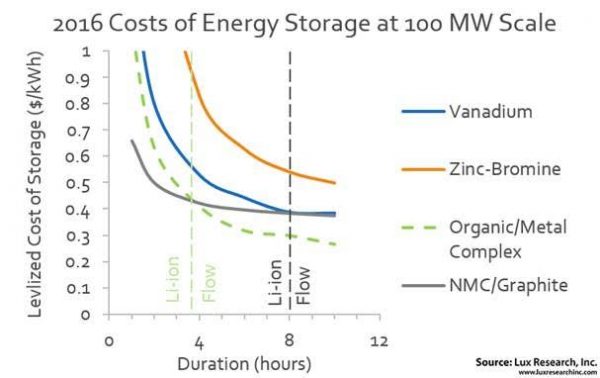Li-ion battery storage key for utilities adopting wind and solar power
Battery storage improves cost and energy density by about 3% annually – Tim Grejtak, Lux
As the global economy electrifies and intermittent renewables gain marketshare, power utilities are increasingly turning to battery storage to stabilize their grids. But which battery storage technologies hold the most promise? A new study from Lux Research says lithium-ion will dominate in the short-term, but new chemistries are being developed that hold promise for the future.
“Utilities are beholden to their customers to provide electricity in the most reliable and cost-effective manner possible. Unfortunately, as renewables [like wind and solar] start to permeate the grid, reliability can degrade,” says Tim Grejtak, analyst and lead author of Future Costs of Stationary Energy Storage: Evaluating Li-ion and Flow Battery Cost Reductions and Application Fit.
“Utilities are totally changing their 150-year-old way of doing business in order to bring about higher penetrations of renewables as quickly as they can manage. If you talk to any utility engineer or business development person or grid scientist, it’s pretty much all hands-on deck.”
Gretjak calls modern power grids “one of the largest synchronized manmade machines in history” and emphasizes that slow change is the best change, that as energy technologies change, all the components need to evolve together.
Including storage technology.
While start ups introduce innovative new ways to store electricity when the wind blows and the sun shines so it can be fed into the grid when needed, batteries are still the most reliable and cost-effective storage option for utilities, according to Gretjak.
 “Li-ion has a lower levellized cost of storage (LCOS) at most durations and system sizes, but the amount of space required starts to drive up costs at larger scales,” he said in an interview.
“Li-ion has a lower levellized cost of storage (LCOS) at most durations and system sizes, but the amount of space required starts to drive up costs at larger scales,” he said in an interview.
“As a result, there’s an opportunity for emerging flow battery technology, which can change this landscape by driving down costs.”
Summary of the report:
- Li-ion retains cost edge. Li-ion beats the most popular vanadium-based flow battery technology on LCOS due to higher round-trip efficiency (83% vs. 65%). Li-ion also dominates the application space from 75 kW to 100 MW, and from 15 minutes of storage to eight hours, with costs above $0.37/kWh.
- New technology will change economics. New chemistries like Lockheed Martin’s metal complex chemistry, planned to debut in 2018, could make flow batteries competitive vs. Li-ion batteries in the highly competitive 4-hour duration market, driving down costs of energy storage and opening up new markets. Current technology won’t get lower than $0.35/kWh.
- Diversification is key as price falls. Application stacking and multiple value streams will gain importance as energy storage costs fall to about $0.30/kWh by 2036. The lower cost will mean no single application market can bring enough revenue to make energy storage economically compelling.
Markham: Please give me an overview of your study on stationary battery storage for power grids.
Grejtak: We’ve seen a great deal of growth in stationary energy storage in the last year or two. It’s mostly been with Li-ion batteries. They’ve been more for short duration applications, but are starting to venture a bit more to longer duration, four hours or so.
The question I wanted to ask is, Will this always be the case? Is it always going to be Li-ion batteries because of their declining cost-curve, their wide-spread availability and supply chains? Or will other alternatives like flow batteries be able to make inroads for different applications?
The answer is, by and large, Li-ion will continue to dominate a large portion of sort of the utilities space, but there are some important and valuable applications that flow batteries can achieve and make inroads toward, especially if you consider new chemistries that re being worked on in the lab today.
Dear Readers. Please take a minute to answer this simple, 10-question readership survey.
Markham: I interviewed Prof. Yi Cui of Stanford a few months ago and he said that over the next decade, lithium ion electric vehicle batteries are likely to drop in cost by 50% and go up 50% in energy density. Does that sound reasonable for stationary battery storage as well?
Grejtak: I definitely think those numbers are accurate. We’ve seen about 3% or so year-on-year improvement in cost and energy density. Those two things to be highly correlated in the sense that for every increment of energy density you can get, that’s one less increment of material that you need to put into a battery.
The nice things is that that ends up working in the consumers’ [both electric vehicles and power utilities] favour in the sense that you now have something that costs less and performs better.
Markham: Are we going to see big “technical disruptions” in battery science or will the improvements be more incremental?
Grejtak: “Step changes” will occur that will definitely advance things. For instance, the move to solid anodes like lithium metal is a great leap forward. But you can also inch there closer with increasingly higher loadings of silicon, which is what Tesla has done. They’ve introduced I think about 3% or 5% silicon loadings into their anodes, which can start to increase the specific energy density of their batteries.
On the cathode, on the lithium metal oxide side, those are sort of established chemistries like MCA or NMC. Those are being worked on, and NMC specifically, to provide increasing energy density without compromising the lifetime or durability of these batteries.
Those are materials science problems that aren’t going away. They won’t just suddenly disappear overnight, unfortunately. I thought that was how science worked, but seven years in the lab taught me otherwise.
Markham: Is it fair to say that 20 to 25 years from now that the battery chemistries in the laboratory today will finally make it to market?
Grejtak: Relative to where we are today? Definitely. but I don’t think it’ll just be suddenly something that we’ve never heard of before. Looking back 25 years from now new batteries will look like a great leap forward, but over time it’ll just be steady incremental improvements with a punctuation mark here or there.
Energy electro-chemistry is a little bit conservative. There are some novel approaches. Stanford is using big data to finding battery materials that electric chemists haven’t quite come up with before. Berkeley has the materials genome. Those approaches can open the aperture a little bit, but by in large the structures and the fundamentals won’t change. The materials might, though.
Bottom line, over time the incremental approach will steadily increase energy density and decrease battery cell costs.








